
CART vs. IRL
Atlas F1 Senior Writer
The Championship Auto Racing Teams (CART) and the Indy Racing League (IRL) have been, for the past few years, fighting to become America's number one single-seater series in a clash in which honour and pride are at stake. Since they split in 1996, both have won battles, but the war is far from over. Atlas F1's Thomas O'Keefe reviews the conflict's current situation and looks at the chances of the civil war of motorsports coming to an end
But now Vietnam is peaceful and war has come to Indianapolis, not a war fought with guns, missiles, tanks and planes and between foreign enemies but a Civil War fought by combatants who used to be in the same family, now armed to the teeth with space age technology, chassis designed in England and in Italy, engines provided by Japan and America and sticky tires produced by Firestone and Bridgestone. The 86th running of the Indy 500 on May 26, 2002, was the latest skirmish in the ongoing Civil War being waged in American open-wheel racing between the Indy Racing League (IRL) and Championship Auto Racing Teams (CART).
What is CART? It is the American single-seater, open-cockpit, open-wheel racing series begun in 1978 whose singular characteristic is its variety and versatility: CART goes racing worldwide in a 19-race series on temporary street circuits like Long Beach, California, Toronto, Canada and Surfers Paradise in Australia, on oval tracks like the historic Milwaukee Mile, the Chicago Motor Speedway, Lausitz, Germany and Rockingham, England and on road racing courses that range from European-style courses like Elkhart Lake, Wisconsin, or the Mid-Ohio course in Lexington, Ohio to more conventional road courses like Portland, Oregon, Monterrey, Mexico, and Laguna Seca, California.
Uniquely, CART will also race this year in Montreal on the Ile Notre Dame Circuit Gilles Villeneuve, the same track used by the Formula One cars, thus providing for the first time a comparison of the agility and speed as between the two different formulas, CART and Formula One. Another significant feature of CART is that it is a public company whose shares are listed on the New York Stock Exchange traded using the stock symbol "MPH".
Until 2002, CART had the lion's share of the "names" in American open-wheel racing, both as to teams and drivers: Roger Penske, Bobby Rahal, Carl Haas, Derrick Walker, Mo Nunn, Pat Patrick, Gerry Forsythe and Barry Green as the leading owners and Gil de Ferran, Michael Andretti, Christian Fittipaldi, Paul Tracy, Dario Franchitti, Christian da Matta as the established drivers along with a continuing influx of talented Brazilians typified by Tony Kanaan and Bruno Junqueira and Mexicans like Michele Jourdain. The cars are a mixture of Lolas and Reynard chassis with 900 bhp 2.65 liter turbocharged engines provided by Honda, Toyota and Ford. Top speed: a 241 mph average speed turned in qualifying at California Speedway in Fontana in 2000 by Gil de Ferran in his Marlboro Honda Reynard.
The engines are unsupercharged 3.5 liter V8's developing 650 bhp, which carry the cars to as high as 230 mph on some tracks. Top Speed: in the first IRL Indy 500 in 1996, Arie Luyendyk turned a qualifying lap of 237 mph. Although the 400,000 or so people who attended the 2002 Indy 500 far exceeded the attendance at the other IRL tracks which continues to grow but has often been sparse, the IRL has the benefit of excellent and imaginative TV coverage on ESPN or ABC and an aggressively fan-friendly approach to its camp followers which has leveraged the IRL in just six years from a fledgling series that many thought would never succeed to a world-class formula that has now taken its place alongside CART and Formula One as the triad of international open-wheel racing.
But there are signs that the IRL's success has come at the expense of and could eventually be the undoing of CART. By any measure, over the past two seasons the IRL has been growing steadily stronger while its older and more prestigious rival has found itself weakened by division amongst team owners and outmaneuvered and diminished in stature in the eyes of its most important constituencies: sponsors, engine suppliers, TV networks, fans and now even one of the Founding Fathers of CART, Roger Penske himself, whose Marlboro Team Penske has won the Indy 500 twelve times and has over 100 victories to his credit in Indy-style cars.
To frame it in terms of American history, in this Civil War of Motorsports, the IRL is the Union, CART is the South and the war is in its intermediate stages, about where the American Civil War was on July 3, 1863, when the Union had dual victories in Gettysburg, Pennsylvania and Vicksburg, Mississippi, which sealed the fate of the South though the war would continue for another two years. CART, like the South in the Civil War, came to the fight with a better reputation for the quality of its people and military prowess. But it should be recalled that the South ultimately succumbed to the overwhelming economic might of the North which, once the fight got underway in earnest, pressed its advantage over the long haul, ultimately exhausting the South's diminished resources and taking back Richmond, Petersburg and Atlanta and repelling the feckless attempts by the South to establish footholds in Maryland and Pennsylvania before the North reversed the tide entirely and sent the South skedaddling back to home ground.
As Lee lost territory in battle after battle with his rival General Ulysses S. Grant, so too is Pook having to yield to the earth moving under his feet, as the IRL's Grant, Tony George, now 42, expands the IRL series by cherrypicking the cream of the crop of ovals CART that have been the staples of CART racing for its entire history: first, the Michigan International Speedway then Fontana Speedway in California and finally the little jewel of a "Bullring" that is the Nazareth Speedway, home track of CART's First Family, the Andretti's, who live minutes from the track, the ultimate insult. Coincidentally, all three of these tracks once belonged to Roger Penske. Finally, taking not only a page but yet another track from CART's playbook, it was recently announced that next season the IRL will go international and run on the famous Twin-Ring Motegi track in Japan, one of CART's premier foreign tracks.
As the dominoes continue to fall against CART's interests, the IRL going racing in Japan was followed up with more bad news for CART from the Pacific Rim: Honda has now announced that it will not return to CART next year but instead will become an engine supplier to the IRL, going head-to-head with Nissan/Infiniti and Chevrolet. Toyota too will develop an IRL engine, following its Japanese counterpart Honda wherever it goes, as it has also done in Formula One where Toyota has fielded its own team in response to Honda's return to Formula One as engine supplier.
With the Japanese engine suppliers focusing on IRL and Formula One, the CART teams may find themselves falling back on the trusty turbocharged Cosworth, making a virtue out of necessity, as CART remains the only open-wheel series running with turbocharged engines. Indeed, on June 16, 2002, on the weekend of the Portland road race, Chris Pook drew a line in the sand in his battle with the IRL, reversing an earlier decision to go with an IRL-like 3.5 liter V8 and instead announcing that the series would be staying with the girl that brought CART to the dance - the turbo.
Having limited the development costs for the team owners by sticking with the turbo and freezing aero advances, Pook has turned to solidifying his relationships with his field generals in this battle, the promoters and race organizers who actually produce the CART FedEx Championship series. In a meeting just before the Laguna Seca race, the promoters emerged as a united front, praising Pook for his leadership and vision in developing marketing, operations and strategic plans to meet the challenge faced by the CART series.
But for all the obvious assets the CART series has in the way of a world class group of drivers, tracks and race cars, a review of the filings CART makes as a public company to the Securities and Exchange Commission ("SEC") reveals a fragile and troubling picture of reduced sponsorship revenue and increased race distribution expenses, accompanied by gyrations downward of CART's stock price. When CART initially went public in March 1998, the stock was priced at $16 per share; a subsequent offering in May 1999 went out at $28 per share and CART's stock had been as high as $35 per share in its salad days just after the 1999 public offering.
In the context of the current tumult in the sport and the general slump in the economy and in the stock market, CART's NYSE symbol "MPH" is crossing the ticker at approximately $9 per share, down from a 52-week high of $17.83. Indeed, CART actually issued a statement on May 31, 2002, in response to a request from the NYSE for comment as to why CART's shares were sliding downward, in which CART declined to comment as a matter of "corporate policy."
Who owns CART's stock? Not surprisingly, some of the long-standing CART team owners like Carl Haas and Pat Patrick have substantial shareholdings and interestingly, during the recent meltdown of the stock in May 2002, at least one of the team owners - Gerry Forsythe of the Players-Forsythe Team, whose driver, Jacques Villeneuve, finished second in the 1994 Indy 500 - pressed his bet in CART by buying $2.4 million worth of more stock on the open market at prices ranging from $14.03 per share on May 3, 2002, to $9.03 per share on May 31, 2002. Forsythe now owns 2,150,000 shares of the 14,718,134 shares of CART outstanding, 14.61% of CART stock.
Floyd R. Ganassi, Jr., known to one and all as "Chip" Ganassi, is another CART team owner with multiple roles. Like Penske, Ganassi is a racer (he competed in all the Indy 500's from 1982-1986) turned racing entrepreneur. Ganassi is a director of CART, runs the Target Chip Ganassi Team which has won the 2000 Indy 500; Ganassi is also the owner and promoter of the Chicago Motor Speedway in Cicero, Illinois, one of the newer CART ovals. As of 2002, CART has restructured its arrangement with the Chicago Motor Speedway, with CART itself being the promoter and leasing the track instead of Ganassi paying sanction fees to CART. Ganassi's executive jet has "N500CK" as the tail number, reflecting the obsession of everyone in the sport, on both sides of the battle lines, with the Indy 500.
Carl Haas, who with actor Paul Newman, owns Newman Haas Racing, has a promotional role with the Texaco Grand Prix in Houston similar to that of Chip Ganassi with Chicago Motor Speedway. Barry Green, owner of Team Green, one of the teams that fielded three cars at the 2002 Indy 500 for Paul Tracy, Dario Franchitti and Michael Andretti, is no longer a CART shareholder, since CART itself repurchased during 2001 80,000 shares of Green's stock at $14.50 per share belonging to Barry Green, "in compliance with our repurchase program which was authorized by the [CART] Board of Directors in April 2002," according to CART's Proxy Statement dated April 24, 2002. As things have turned out, Barry Green was as good at market timing as he is at timing the strategic moves of Team Green from the pit wall during a race.
Indeed, if there were ever to be a merger of CART and IRL of a substantive nature, CART's status as a public company would create a significant legal obstacle that would have to be resolved. Presumably, one way to position CART for an ultimate combination with the privately-held IRL, is to do what Forsythe is doing with his purchasing program and what CART did with Barry Green's shares: Going Private, by using CART's funds or those of its principal shareholders to buy back stock from the public at the prevailing bargain basement prices. Once the redemption or repurchase program is complete, CART would then have the latitude to deal with the IRL on an equal footing.
Not only did CART lose ABC; worse, the giant network did not go quietly. ABC Sports President Howard Katz minced no words on the eve of ABC televising its 86th Indy 500, explaining why ABC had extended its contract for ABC and ESPN to televise all 15 IRL races through 2007. Said Katz bluntly: "There's not enough money, there's not enough advertising support, there's not enough sponsorship. There is not enough room for both U.S.-based open-wheel series. You can only promote so many things: with more than one racing series out there, we have to make sure all our energy and focus is on the IRL."
With these business and legal developments going on behind the scenes, the 2002 Indy 500 proved to be the event where the transformation of the IRL from stepchild to favorite son was on full display. In 1996, the first year of the CART/IRL civil war, in an act of bravado CART defiantly held the "US 500" at the then-Penske-owned Michigan International Speedway on the same day as the IRL's first Indy 500. Tellingly, six years later, there is no defiance left in CART, which went out of its way this year to schedule its season in order to permit any of the CART teams who wanted to, to buy IRL-spec cars and compete in the Indy 500.
And come they did, most of the leading teams from CART. The pioneer was Chip Ganassi of the Target-sponsored Chip Ganassi Racing team, who bucked the odds before it was fashionable to do so at the 2000 Indy 500, by running the CART race at Nazareth on Saturday, May 27, 2000 and the Indy 500 on the very next day, nearly winning both.
As it was, the 2000 Indy 500 turned out to be a kind of highwater mark for CART in this civil war, as CART's Juan Pablo Montoya (now in Formula One with the BMW-Williams team) convincingly defeated the IRL's Buddy Lazier in a straight fight that had the fans on their feet in the grandstands lining the front straight at Indy.
But in retrospect the 2000 Indy 500 was a Pickett's Charge of sorts and by the 2002 Indy 500, CART was in full retreat. In addition to Penske's formal defection from the series because his main sponsor Marlboro wanted the exposure of the Indy 500, Team Green's three-car team of Andretti, Tracy and Franchitti competed in the 2002 Indy 500, joining IRL stalwarts like A.J. Foyt, Harrah's Casino team and Eddie Cheever's Red Bull team. CART regular Chip Ganassi, returned this year to Indy with a three-car team of his own; Mo Nunn fielded a two-car team and even ex-CART Interim CEO Bobby Rahal entered a car for Jimmy Vassar, winner of the inaugural US 500 back in those halcyon days for CART early in the war when victory seemed just a matter of time.
Even the celebrities were back, with actress Ashley Judd in the pits with her husband Dario Franchitti and her co-star in the movie High-Crimes, Jim Caviezel, driving the Corvette Pace Car. Singer John Mellencamp and his wife and model Elaine Irwin Mellencamp, were much on display promoting the IRL and the Indy 500 in song and in personal appearances. And Indian's own, Dave Letterman, was back home in Indiana, signing autographs in Gasoline Alley and on the grid for fans that descended upon him in great numbers as he hung out with the mechanics on the No. 19 Miller Lite car fielded by Rahal Letterman Racing and driven by Jimmy Vassar. Finally, music video channel MTV and rap singer Ice Tea and his entourage of celebrities made an appearance at Indy to sponsor George Mack, the first black in a decade to run in the Indy 500 for the Los Angeles-based "310" team, the area code there for those who don't know the Left Coast.
The great shame in all of this is that, as in the American Civil War, both the IRL and CART have fabulous generals and brave soldiers doing courageous acts of derring-do week after week that will live long in the annals of open-wheel racing. The IRL's Sam Hornish, 22 years old, is in the best traditions of the Indy 500 and is as brash, brave and charismatic as his predecessor in interest, Indy 500 legend and four-time winner A.J. Foyt, and CART's senior driver Michael Andretti, now 39, is as exciting, committed and versatile a racer as has ever stepped into a race car, leading more laps at the Indy 500 than any non-winner, as well as having reached a podium finish in the Italian Grand Prix during his one year in Formula One and even having competed in the Le Mans 24-Hour Endurance Race.
Ironically, as the Civil War of Motorsports unfolds in earnest, the fans, at least for now, are the chief beneficiaries of this embarrassment of riches, sometimes having the luxury of watching an IRL race on Saturday night and a CART race on Sunday afternoon, both series aggressively competing for a similar audience at the racetracks and on TV. But realistically, how long can both sides continue at this breakneck pace to see who can stay the course longer than the other? Will CART's product be successfully re-packaged by Chris Pook to a sufficient amount of new and old sponsors and fans to permit CART to stabilize and thrive in a series that dares to do more than any other series in the world? Or will Tony George's ownership of the brooding omnipresence of the Mothership of all racetracks, the Indianapolis Motor Speedway, be the sine qua non without which no series can survive, guaranteeing that the IRL will be alone in Victory Lane when the motors fall silent?
How and when will the CART/IRL civil war end? Will there be a "merger" between the two different forms of racing with the IRL expanding its horizons to include road racing for the first time from venues transferred into the pot by CART? Or will CART be unwilling or unable to extract itself from its downward spiral because of the corporate and legal constraints that are part of the baggage of being a publicity-owned company owned by shareholders? And, most critically, regardless of what CART plans to do to keep its series afloat, will Tony George and the IRL mercilessly turn the screws even further than they have this year to entirely humble and eradicate its adversary which is wobbling and on the ropes?
The last word goes to the Captain, a racer himself in his youth and a phenomenally successful businessman later on who still seems happiest not in a Board Room but on a pit wall somewhere every other Sunday in the summer. When asked about the subject of the CART/IRL rivalry during the 2002 Indy 500 weekend, Roger Penske read the tea leaves for the rest of us usually referring to CART not by name but as "the other series":
In the end, when Appomattox comes and this Civil War of Motorsports ends, it will in all likelihood be up to Tony George, as the "someone" who will dictate the terms. If and when the times comes, will Tony George demand unconditional surrender and treat CART and its team owners and legacy like a conquered nation or will he, like General Grant at Appomattox on April 9, 1865, be magnanimous in victory, as Grant was to Lee, and allow the defeated to go home with their side arms, their horses and their dignity, knowing that the sheer joy of exacting the last ounce of revenge should give way to the greater good of uniting all open-wheel American racing, oval tracks and road racing alike, under one roof. "A house divided against itself cannot stand," said President Abraham Lincoln, who came to learn a thing or two about keeping peace in the family. Let us hope as we slouch toward Appomattox that the leaders of CART and the IRL are students of history.
My mother is from Indiana and I have been going to the Indianapolis 500 since I was a teenager, when I was lucky enough to be a film "runner" for my uncle, Bill Krider, a UPI photographer from Lawrenceburg, Indiana. I have been there since the days when Parnelli Jones and A.J. Foyt were running the front-engined roadsters with their WWII vintage Offenhauser engines wedged into tube-framed chassis designed by Frank Kurtis and A.J. Watson. I have been there for the rain delays and rain-shortened races in 1973, 1975 and 1976. And I was there the day Scotland's Jimmy Clark changed Indy forever and made the front-engined "dinosaurs" extinct by winning the 1965 Indy 500 in his spindly green and yellow rear-engined British Lotus, powered by Ford.
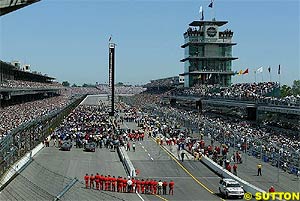 When I was drafted and sent to Vietnam, I listened to the race on Armed Forces Radio half a world away in the wee hours of the morning, Al Unser Sr.'s victory in the "Johnny Lightning Special" making the war more tolerable for me at least that day.
When I was drafted and sent to Vietnam, I listened to the race on Armed Forces Radio half a world away in the wee hours of the morning, Al Unser Sr.'s victory in the "Johnny Lightning Special" making the war more tolerable for me at least that day.
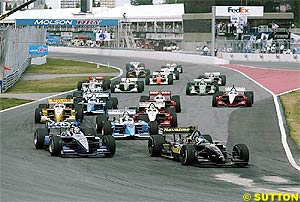 What is the IRL? It is the open-wheel racing series begun in 1996 by Tony George, President and Chief Executive Officer of the Indianapolis Motor Speedway, with the Indy 500 itself as the centerpiece of the series. The IRL currently concentrates exclusively on oval track racing in a 15- race series that has expanded since 1996 to embrace a range of oval tracks, new and old, long and short, from the majestic 2.5 mile oval at Indianapolis to the tiny less than a mile oval at Nazareth, Pennsylvania. In between these extremes, there is night racing under the lights on the high banking at Texas Motor Speedway, traditional oval racing at Homestead, Florida and Phoenix, Arizona and new ovals in Kansas and Kentucky.
What is the IRL? It is the open-wheel racing series begun in 1996 by Tony George, President and Chief Executive Officer of the Indianapolis Motor Speedway, with the Indy 500 itself as the centerpiece of the series. The IRL currently concentrates exclusively on oval track racing in a 15- race series that has expanded since 1996 to embrace a range of oval tracks, new and old, long and short, from the majestic 2.5 mile oval at Indianapolis to the tiny less than a mile oval at Nazareth, Pennsylvania. In between these extremes, there is night racing under the lights on the high banking at Texas Motor Speedway, traditional oval racing at Homestead, Florida and Phoenix, Arizona and new ovals in Kansas and Kentucky.
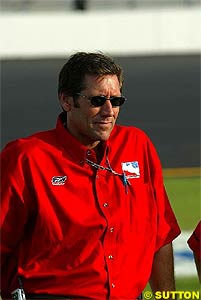 In CART's case, there have been three management shuffles in as many years and, as we have seen, one of CART's Generals, "the Captain," Roger Penske, has switched sides and gone over the IRL not necessarily because he wanted to but because his chief sponsor, Marlboro, wanted him to. Although the current CART Commanding General, Chris Pook, now 61 years old, is as savvy and sophisticated as they come, having nurtured Long Beach from a ramshackle seaside town to a world-class sports and tourist venue first for Formula One racing in 1976 and later on for CART, even Robert E. Lee could not triumph over the long odds he faced for all of Lee's daring and commitment to the cause of the South.
In CART's case, there have been three management shuffles in as many years and, as we have seen, one of CART's Generals, "the Captain," Roger Penske, has switched sides and gone over the IRL not necessarily because he wanted to but because his chief sponsor, Marlboro, wanted him to. Although the current CART Commanding General, Chris Pook, now 61 years old, is as savvy and sophisticated as they come, having nurtured Long Beach from a ramshackle seaside town to a world-class sports and tourist venue first for Formula One racing in 1976 and later on for CART, even Robert E. Lee could not triumph over the long odds he faced for all of Lee's daring and commitment to the cause of the South.
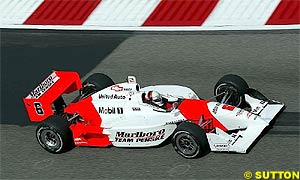 Like the Confederacy when it was under siege, in the face of these adverse developments, CART has put itself on a war footing and is scrambling to protect and enhance the franchise it has in whatever way it can, while at the same time tightening its belt to see the series through during these "war" years. On the eve of the Laguna Seca road race on June 9, 2002, in a move to cut costs and increase competition, the CART teams agreed to a "freeze" on development of major aerodynamic components until the completion of the 2003 season, although tweaking minor aero components would be permitted. By way of comparison, certain of the top teams in Formula One run their wind tunnels on a 24/7 basis and the main increases in performance race to race result from the "aero bits" produced by all this ongoing development.
Like the Confederacy when it was under siege, in the face of these adverse developments, CART has put itself on a war footing and is scrambling to protect and enhance the franchise it has in whatever way it can, while at the same time tightening its belt to see the series through during these "war" years. On the eve of the Laguna Seca road race on June 9, 2002, in a move to cut costs and increase competition, the CART teams agreed to a "freeze" on development of major aerodynamic components until the completion of the 2003 season, although tweaking minor aero components would be permitted. By way of comparison, certain of the top teams in Formula One run their wind tunnels on a 24/7 basis and the main increases in performance race to race result from the "aero bits" produced by all this ongoing development.
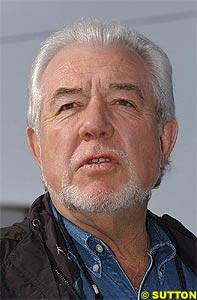 Why is Forsythe buying? According to Forsythe's Schedule 13D SEC filing, because he "believe[s] that the trading prices of the [CART] Common Stock in the public market do not accurately reflect the potential value of the Company's underlying businesses and assets." Forsythe is a long term investor in CART and has multiple roles in the sport: he is a race team owner and a principal owner of the entities which entered into multi-year Promotor Agreements with respect to the new CART races in Rockingham, England and in Mexico, both the Monterrey and Mexico City races. The Forsythe-controlled entities have agreed to pay sanction fees to CART of $10.9 million in 2002. Forsythe also owns TV broadcasting rights for the Mexico races.
Why is Forsythe buying? According to Forsythe's Schedule 13D SEC filing, because he "believe[s] that the trading prices of the [CART] Common Stock in the public market do not accurately reflect the potential value of the Company's underlying businesses and assets." Forsythe is a long term investor in CART and has multiple roles in the sport: he is a race team owner and a principal owner of the entities which entered into multi-year Promotor Agreements with respect to the new CART races in Rockingham, England and in Mexico, both the Monterrey and Mexico City races. The Forsythe-controlled entities have agreed to pay sanction fees to CART of $10.9 million in 2002. Forsythe also owns TV broadcasting rights for the Mexico races.
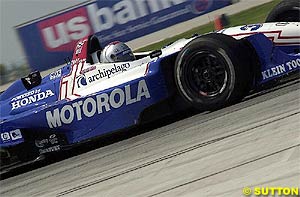 In the American Civil War, foreign countries played a role in the outcome, by supporting or withholding support to one side or the other at critical moments in the war; in particular, the failure of the South to convince its trading partner England to support the rebellion turned out to be one of the nails in the coffin for the South. In the Civil War of Motorsports, the TV networks are foreign countries of sorts whose moves help or hurt the position of the main combatants. For the 2002 season, CART found itself abandoned by the ABC/ESPN family of channels that together had been an integral part of CART's success for decades.
In the American Civil War, foreign countries played a role in the outcome, by supporting or withholding support to one side or the other at critical moments in the war; in particular, the failure of the South to convince its trading partner England to support the rebellion turned out to be one of the nails in the coffin for the South. In the Civil War of Motorsports, the TV networks are foreign countries of sorts whose moves help or hurt the position of the main combatants. For the 2002 season, CART found itself abandoned by the ABC/ESPN family of channels that together had been an integral part of CART's success for decades.
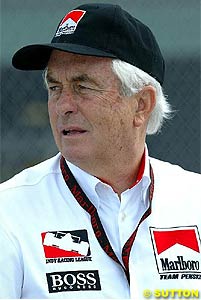 As a result, the 2002 Indy 500 was quite a sight. For some of these teams and drivers, it was the first time back at Indy since 1995 and the Darwinian process of separating wheat from chaff meant that the one of the strongest fields in Indy 500 history took to the grid on May 26, 2002 and produced a race that harkened back to the kind of races that made the Indianapolis Motor Speedway the legend that it is: rookies doing battle with prior winners, nine different leaders, Americans, Brazilians, a Frenchman, a Scot, an Italian, a South African and a Swede, a United Nations of Motorsport participating. For one day, open-wheel racing fans were treated to what it is like when the best of the CART and IRL teams compete on the same track at the same time.
As a result, the 2002 Indy 500 was quite a sight. For some of these teams and drivers, it was the first time back at Indy since 1995 and the Darwinian process of separating wheat from chaff meant that the one of the strongest fields in Indy 500 history took to the grid on May 26, 2002 and produced a race that harkened back to the kind of races that made the Indianapolis Motor Speedway the legend that it is: rookies doing battle with prior winners, nine different leaders, Americans, Brazilians, a Frenchman, a Scot, an Italian, a South African and a Swede, a United Nations of Motorsport participating. For one day, open-wheel racing fans were treated to what it is like when the best of the CART and IRL teams compete on the same track at the same time.
"I think my goal here is to see both organizations [CART and IRL] end up in the same way together with an opportunity to have one open-wheel series. Obviously, they're going down two different paths. We have one oval and we have one road-racing series. At some point, someone will have to make a decision."
Please Contact Us for permission to republish this or any other material from Atlas F1.
|
Volume 8, Issue 35
Articles
A Question of Speed: CART vs. F1
Civil War of Motorsports: CART vs. IRL
Jo Ramirez: a Racing Man
Belgian GP Preview
The Belgian GP Preview
Local History: Belgian GP
Belgium Facts, Stats & Memoirs
Columns
The Belgian GP Quiz
Bookworm Critique
Elsewhere in Racing
The Grapevine
> Homepage |